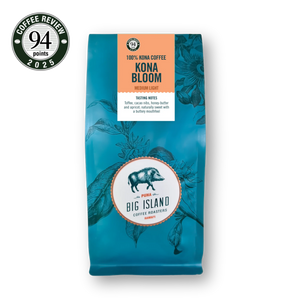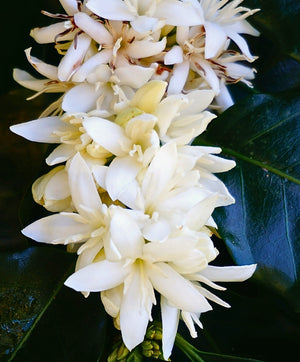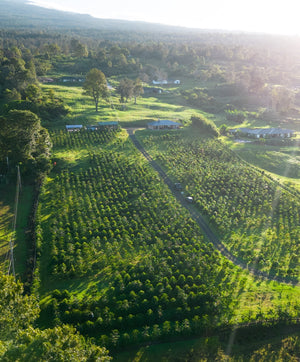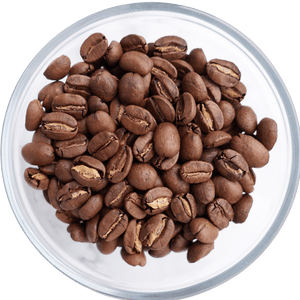Gifting has never been easier
Perfect if you're short on time or are unable to deliver your gift yourself. Enter your message and select when to send it.




Delicate, juicy, and lush — Kona Bloom is a medium-light roast crafted for those who crave a bright, buttery, and sweeter expression of traditional 100% Kona coffee. It’s a refined take on the same variety and processing methods that have defined Kona coffee since the late 1800s.
Sourced from the same Kona farm as our beloved Kona Moon dark roast, Kona Bloom reveals the elegant, fruit-forward side of Kona’s famed terroir, offering naturally sweet notes of jasmine, peach, honey, caramel, and toffee.
In 2025, Kona Bloom earned an exceptional 94-point score from Coffee Review, which described it as:
“Rich-toned, deeply sweet… A 100% Kona coffee that delivers classic notes throughout the profile: crisp chocolate, spice-toned florals, stone fruit and rich aromatic wood, all in harmonious agreement around gentle acidity and a plush mouthfeel.”
What sets Kona Bloom apart? In addition to harvesting ripe Kona coffee cherry, we select larger bean sizes — Fancy and Extra Fancy grades — not only for their beauty but for their clarity in the cup. These beans undergo additional refinement that removes defects often found in commodity-grade Kona, 10% blends, and less discerning brands — the culprits behind unbalanced, harsh, overly acidic or bitter cups.
We believe anything less is a disservice to the heritage, reputation, and consumers of Kona coffee.
Each Kona Bloom lot undergoes three extra quality steps before roasting:
Perfect for pour-over, filter, or gentle immersion methods, Kona Bloom stands in contrast to commodity Kona — delivering a cup that’s consistently smooth, clean, and rich in complexity.
Roasted-to-order at our Hilo flagship café and roastery, Kona Bloom is a refined expression of Kona's coffee heritage.
| Order | Cost & Carrier | Delivery |
|---|---|---|
| ≤$89 | $10.95 via USPS/FedEx | 6-9 days* |
| Over $89 | Free FedEx (USPS if PO Box) | 4-6 days* |
| Expedited | $24.95 via FedEx 2Day | 3-5 days** |
* Delivery quote excludes weekends/holidays and is based on fulfillment+delivery times. Does not include delays that are caused by carrier or out of our control.
** Upgraded and expedited shipping may be purchased at the time of checkout. ‘Expedited’ prioritizes your shipment in the queue. Delivery quote excludes weekends/holidays and is based on fulfillment+delivery times.
Orders are roasted Sunday-Friday and shipped Monday-Friday. Roast dates are applied to the bags in your order.
*Rural locations may incur additional fees at checkout.
| Hawaii to Canada* | Varies based on Territory |
|---|---|
| Up to 1 lb: | $17.29-$18.58 |
| 2-5 lbs: | $17.35-$25.28 |
| 6-10 lbs: | $21.84-$29.76 |
| 11-15 lbs: | $29.14-$44.21 |
| 16-20 lbs: | $35.76-$48.72 |
| 21-25 lbs: | $42.95-$55.63 |
| 26-30 lbs: | $55.07-$70.03 |
| 31-99 lbs: | $59.63-$125.86 |
| 100+ lbs: | Email for quote |
|
De Minimis for Duty |
De Minimis for VAT |
|---|---|
| $150 CAD | $40 CAD |
|
Hawaii to Germany, United Kingdom* |
|
|---|---|
| Up to 1 lb: | $17.62 |
| 2-5 lbs: | $17.64-$25.22 |
| 6-10 lbs: | $25.67-$29.08 |
| 11-15 lbs: | $41.44-$50.04 |
| 16-20 lbs: | $53.98-$58.28 |
| 21-25 lbs: | $61.46-$62.84 |
| 26-30 lbs: | $83.21-$88.46 |
| 31-99 lbs: | $90.07-$165.31 |
| 100+ lbs: | Email for quote |
| De Minimis for Duty | De Minimis for VAT |
|---|---|
| 150 EUR | 22 EUR |
| 135 GBP | 15 GBP |
|
Hawaii to Japan, South Korea* |
|
|---|---|
| Up to 1 lb: | $17.64 |
| 2-5 lbs: | $20.93-$31.81 |
| 6-10 lbs: | $34.32-$41.56 |
| 11-15 lbs: | $43.99-$53.74 |
| 16-20 lbs: | $53.84-$61.03 |
| 21-25 lbs: | $63.48-$67.64 |
| 26-30 lbs: | $75.35-$92.33 |
| 31-99 lbs: | $94.17-$189.94 |
| 100+ lbs: | Email for quote |
| De Minimis for Duty | De Minimis for VAT |
|---|---|
| 10,000 JPY | 200,999 JPY |
| 150,000 KRW** | 150,000 KRW |
| ** price of goods+shipping cost+insurance | |
| Hawaii to Australia* *Rural locations may incur additional costs at checkout |
|
|---|---|
| Up to 1 lb: | $20.70 |
| 2-5 lbs: | $22.16-$30.40 |
| 6-10 lbs: | $29.33-$36.40 |
| 11-15 lbs: | $55.54-$72.31 |
| 16-20 lbs: | $76.98-$85.37 |
| 21-25 lbs: | $91.27-$93.29 |
| 26-30 lbs: | $122.59-$126.73 |
| 31-99 lbs: | $126.77-$245.34 |
| 100+ lbs: | Email for quote |
| De Minimis for Duty | De Minimis for VAT |
|---|---|
| 1000 AUD | None |
* Please note that customs and duties are displayed at checkout. All costs listed are estimates.
Because Espresso Bites are made without stabilizers or preservatives, they may bloom or melt when shipping temperatures exceed 80 F. If this is a concern in your location please select FedEx shipping.
If you notice a white color to your bar, it's perfectly safe to eat. This happens when the cocoa butter softens and migrates to the surface. It happens more often when shipping in warm weather. Learn more about blooming.
Espresso Bites that melt or bloom when shipped via FedEx are eligible for a full refund or credit.
Espresso Bites that melt or bloom when the buyer elects Free Shipping or standard USPS are eligible for a credit.
If your order is incorrect or damaged in any way, please email us at hello@bigislandcoffeeroasters.com with your order number within 7 days of receiving your order.
Big Island Coffee Roasters, 76 Kalanianaole St. Hilo, HI 96720
Our Hawaiian coffees are roasted to order and milled in small batches. Each bag is date stamped, so you know when it was roasted.
What's so important about fresh roasted coffee?
The fresher the coffee, the more intensity you’ll get because great flavors and aromas fade over time.
For some, 100% Kona coffee is the peak of the coffee experience. Others may have no idea what Kona coffee means and why it matters -- but it only takes a sip to create a Kona coffee convert. However, there are lots of purported Kona coffee brands, and some might actually be Kona coffee in name only, so it's important to know what to look for when you're on a quest for the most exquisite coffee taste in the world.
It all starts with the coffee tree. Technically, coffee grows on flowering shrubs, but whether you call it a plant, a bush or a tree won't change how coffee cherry seeds are raised and processed into what we know as coffee. Ever since coffee was introduced to Hawaii in the early 19th century, coffee making has expanded across the islands with various varieties, though the most dominant is known as Kona Typica.
Originating in Guatemala, Kona Typica has thrived in the climate and soil of Kona, which is a small growing region just two miles long on the western edge of the Big Island. A member of the coffea arabica family, Kona Typica coffee is a high-quality coffee bean that's more difficult to cultivate than its close cousin, coffea rusika, but it yields a smooth taste with low acidity and a heavy body.
Trimmed short at about a foot or less, Kona coffee is hand-picked from its bushy trees when the cherries that contain the coffee bean are ripe red, which is the ideal and perfect time for harvesting.
What is 100% Kona?
Just like how champagne can only be made from grapes grown in the Champagne wine region in Northeastern France, 100% Kona coffee only comes from a specific region in Hawaii known as the Kona Coffee Belt. That means only Kona coffee grown in the Kona Coffee Growing Region can be deemed 100% Kona coffee.
The Kona coffee region is a short, two-mile-long area on the western edge of the Kona island, with altitudes that range from 600 to 2,500 ft. Believe it or not, but this small region has hundreds of small farms, each with no more than a few acres. Some of the larger farms may have a few hundred acres, but compared to other coffee growers worldwide, Kona coffee production is rather limited.
Kona Coffee Conditions
Because Kona coffee grows in specific conditions unique to the Kona region of the Big Island, there's a lot that goes into the Kona medium roast or Kona coffee espresso that ends up in your cup.
The first important factor is elevation, which gives 100% Kona coffee the ideal temperature and precipitation needed to grow its delicious coffee beans. High up in the hills of Hualalai and Mauna Loa, temperatures are much cooler than the balmy coastal areas, which allows the beans to mature more slowly, resulting in a more complex, denser coffee bean.
The heavy rains that the region sees also gives the beans an ample amount of fresh water with an average of 60 inches of rain per year. Sure, it might not rain that much in the coastal regions, but up on the Kona hills, rain is a frequent and welcome sight for those growing 100% Kona coffee on the steep slopes.
But the rain isn't the only welcome sight in the Kona growing region -- rainclouds also provide the necessary shade to keep the coffee trees cool and locked in with moisture that would otherwise evaporate away in the hot Hawaiian sun. It's this slow development that makes for a denser and more flavorful bean, which is what gives 100% Kona coffee its full-bodied and rich taste.
Slope is also important to making a great bag of 100% Kona medium roast like our Kona Bloom coffee, and the ideal slope helps keep moisture from building up at the roots, causing root rot, or flowing away too quickly for the coffee tree to get adequate hydration.
The area's volcanic soil also helps establish ideal conditions for growing coffee beans as it contains valuable nutrients that the Kona coffee plant needs to grow and flourish. Unlike other types of soil, the region's rich soil also quickly absorbs moisture yet is dense enough (along with slope) to reject root rot by preventing pooling.
Evaluating the Numbers
While most coffee production in the world is governed by large plots, large yields and large-scale agricultural work, the Kona coffee region yields just two million pounds of Kona coffee on under 3,000 acres or 30 hectares. Brazil, by comparison as the largest coffee producer in the world, devotes more than two million hectares of land to grow almost 5 billion pounds of coffee.
That means that even the largest operation in Kona is quite small by global standards. But it's those small grows that are actually part of what makes 100% Kona coffee so delicious -- Kona coffee is grown more precisely and attentively by hand, and growers have a closer, more intimate relationship with the coffee beans grown in Kona more than anywhere else in the world.
While other coffees might stand out because of the size of their operation, elevation or precipitation, Kona coffee has just that right balance of all factors that makes it one of the best tasting cups of coffee anywhere. Other coffees may do one thing well -- like Colombian coffees that are grown in high elevation, African coffees that are grown in earthy soils, and the sheer variety of South American coffees -- but only 100% Kona coffee really checks all the boxes.
Kona coffees receive an ideal amount of sun and precipitation, and the soil is perfectly balanced for both. The passion of the growers also can't be overstated, which enables Kona coffee to be grown consistently season after season, making 100% Kona coffee a delicious treat year after year.
Our Hawaiian coffees are roasted to order and milled in small batches. Each bag is date stamped, so you know when it was roasted.
What's so important about fresh roasted coffee?
The fresher the coffee, the more intensity you’ll get because great flavors and aromas fade over time.
For some, 100% Kona coffee is the peak of the coffee experience. Others may have no idea what Kona coffee means and why it matters -- but it only takes a sip to create a Kona coffee convert. However, there are lots of purported Kona coffee brands, and some might actually be Kona coffee in name only, so it's important to know what to look for when you're on a quest for the most exquisite coffee taste in the world.
It all starts with the coffee tree. Technically, coffee grows on flowering shrubs, but whether you call it a plant, a bush or a tree won't change how coffee cherry seeds are raised and processed into what we know as coffee. Ever since coffee was introduced to Hawaii in the early 19th century, coffee making has expanded across the islands with various varieties, though the most dominant is known as Kona Typica.
Originating in Guatemala, Kona Typica has thrived in the climate and soil of Kona, which is a small growing region just two miles long on the western edge of the Big Island. A member of the coffea arabica family, Kona Typica coffee is a high-quality coffee bean that's more difficult to cultivate than its close cousin, coffea rusika, but it yields a smooth taste with low acidity and a heavy body.
Trimmed short at about a foot or less, Kona coffee is hand-picked from its bushy trees when the cherries that contain the coffee bean are ripe red, which is the ideal and perfect time for harvesting.
What is 100% Kona?
Just like how champagne can only be made from grapes grown in the Champagne wine region in Northeastern France, 100% Kona coffee only comes from a specific region in Hawaii known as the Kona Coffee Belt. That means only Kona coffee grown in the Kona Coffee Growing Region can be deemed 100% Kona coffee.
The Kona coffee region is a short, two-mile-long area on the western edge of the Kona island, with altitudes that range from 600 to 2,500 ft. Believe it or not, but this small region has hundreds of small farms, each with no more than a few acres. Some of the larger farms may have a few hundred acres, but compared to other coffee growers worldwide, Kona coffee production is rather limited.
Kona Coffee Conditions
Because Kona coffee grows in specific conditions unique to the Kona region of the Big Island, there's a lot that goes into the Kona medium roast or Kona coffee espresso that ends up in your cup.
The first important factor is elevation, which gives 100% Kona coffee the ideal temperature and precipitation needed to grow its delicious coffee beans. High up in the hills of Hualalai and Mauna Loa, temperatures are much cooler than the balmy coastal areas, which allows the beans to mature more slowly, resulting in a more complex, denser coffee bean.
The heavy rains that the region sees also gives the beans an ample amount of fresh water with an average of 60 inches of rain per year. Sure, it might not rain that much in the coastal regions, but up on the Kona hills, rain is a frequent and welcome sight for those growing 100% Kona coffee on the steep slopes.
But the rain isn't the only welcome sight in the Kona growing region -- rainclouds also provide the necessary shade to keep the coffee trees cool and locked in with moisture that would otherwise evaporate away in the hot Hawaiian sun. It's this slow development that makes for a denser and more flavorful bean, which is what gives 100% Kona coffee its full-bodied and rich taste.
Slope is also important to making a great bag of 100% Kona medium roast like our Kona Bloom coffee, and the ideal slope helps keep moisture from building up at the roots, causing root rot, or flowing away too quickly for the coffee tree to get adequate hydration.
The area's volcanic soil also helps establish ideal conditions for growing coffee beans as it contains valuable nutrients that the Kona coffee plant needs to grow and flourish. Unlike other types of soil, the region's rich soil also quickly absorbs moisture yet is dense enough (along with slope) to reject root rot by preventing pooling.
Evaluating the Numbers
While most coffee production in the world is governed by large plots, large yields and large-scale agricultural work, the Kona coffee region yields just two million pounds of Kona coffee on under 3,000 acres or 30 hectares. Brazil, by comparison as the largest coffee producer in the world, devotes more than two million hectares of land to grow almost 5 billion pounds of coffee.
That means that even the largest operation in Kona is quite small by global standards. But it's those small grows that are actually part of what makes 100% Kona coffee so delicious -- Kona coffee is grown more precisely and attentively by hand, and growers have a closer, more intimate relationship with the coffee beans grown in Kona more than anywhere else in the world.
While other coffees might stand out because of the size of their operation, elevation or precipitation, Kona coffee has just that right balance of all factors that makes it one of the best tasting cups of coffee anywhere. Other coffees may do one thing well -- like Colombian coffees that are grown in high elevation, African coffees that are grown in earthy soils, and the sheer variety of South American coffees -- but only 100% Kona coffee really checks all the boxes.
Kona coffees receive an ideal amount of sun and precipitation, and the soil is perfectly balanced for both. The passion of the growers also can't be overstated, which enables Kona coffee to be grown consistently season after season, making 100% Kona coffee a delicious treat year after year.
Gifting has never been easier
Perfect if you're short on time or are unable to deliver your gift yourself. Enter your message and select when to send it.